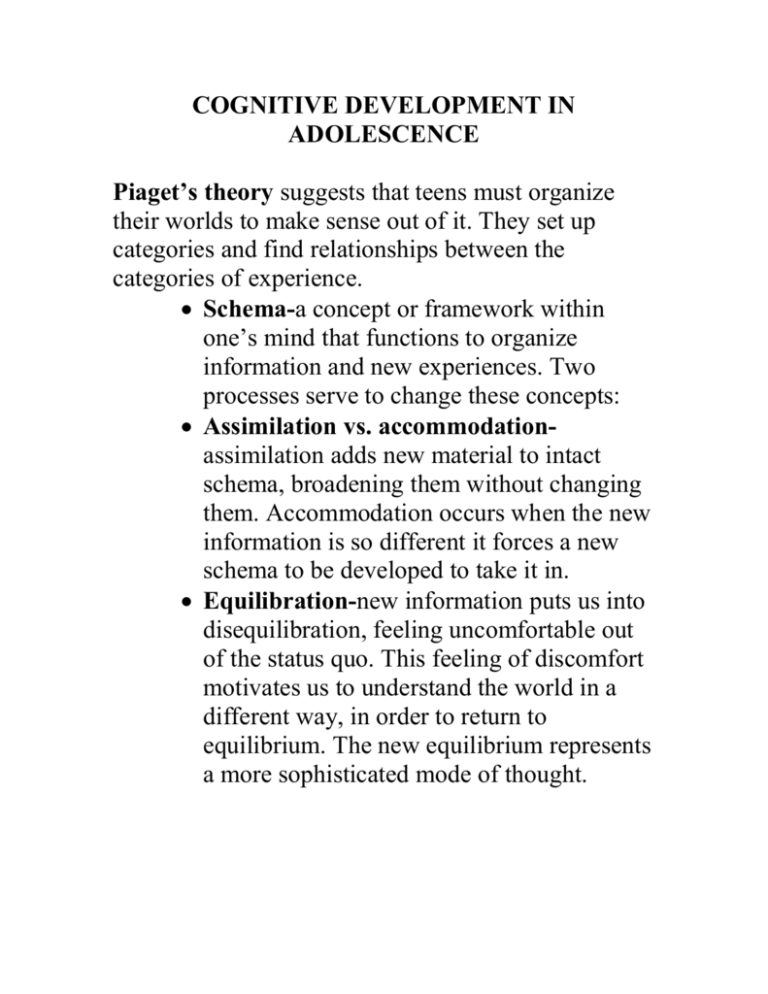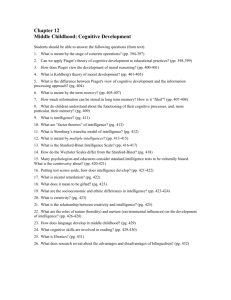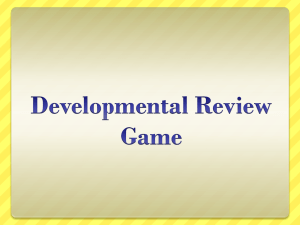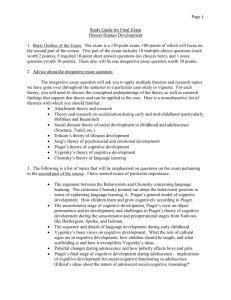Piaget's theory
advertisement

COGNITIVE DEVELOPMENT IN ADOLESCENCE Piaget’s theory suggests that teens must organize their worlds to make sense out of it. They set up categories and find relationships between the categories of experience. Schema-a concept or framework within one’s mind that functions to organize information and new experiences. Two processes serve to change these concepts: Assimilation vs. accommodationassimilation adds new material to intact schema, broadening them without changing them. Accommodation occurs when the new information is so different it forces a new schema to be developed to take it in. Equilibration-new information puts us into disequilibration, feeling uncomfortable out of the status quo. This feeling of discomfort motivates us to understand the world in a different way, in order to return to equilibrium. The new equilibrium represents a more sophisticated mode of thought. Stages of Cognitive Development-Operations (Logic) Sensorimotor-Birth to 2 yrs. When knowedge comes through the senses and locomotion and these varied experiences become coordinated. It begins with reflexes, and ends when symbolic thought begins- language. Preoperational-2-7 yrs. As children represent the world with words and make-believe. Fantasy and make-believe is important to development. Concrete operational-7 – 11 yrs. Conservation & classification skills come in as children begin to use logic (operations) to solve problems in their heads. Conservation means the ability to understand that if nothing is added or taken away from an item, even if it changes form, it’s the same amount. This concept is essential for mastering math. Classification is when children organize items into groups, hierarchies and classes. You will notice children this age developing collections as they try to master this. Formal operational- puberty into adulthood as logic extends to abstract concepts, future, ideals. Hypothetical-deductive reasoning- the ability to think like a scientist, to formulate hypotheses and test them in a deductive fashion. o Early formal operational thought-they have far-ranging thought into all the possibilities, much fantasy thought without a lot of connection to reality (Examples are seen in their concepts of a possible career) o Late formal operational thought-thought returns to a greater balance as real issues are integrated with ideals. Transition into this level of thinking is not as dependent on age as experience and life consequences. There is also a higher form of thinking in the areas the teen has most experience. Expertise allows for more elaborate thought. Piaget’s theory related to Education He stresses that children construct knowledge through their own experiences and experimentation. Teachers need to listen to teen’s ideas to understand what they know and to structure educational experiences that allow them to explore what they have interest in. Education should be set up to meet individual needs more specifically. Also it should not be so formal and abstract that those teens who haven’t reached this level of thought will be handicapped. Critique of Piaget’s theory- he underestimated their abilities at the ages he set. Levels of thought can be trained. So a child in one stage can be trained to think at the higher level. Piaget believed development leads learning. The child must be ‘ready’ to learn a concept and that depends on natural developmental markers. Culture also makes a difference in what skills are practiced and what sort of thinking that is. Some cultures have little formal thought. NeoPiagetians are undertaking to revise Piaget to emphasize how children process information and retrieve it later. Vygotsky’s theory-stressed that knowledge is collaborative (and best learned in cooperation with others) and comes through various environments and experiences. Zone of Proximal development-the difference between what a child can do independently and what s/he can do with some aid by a more skilled person. Scaffolding-this is Vygotsky’s concept of changing the level of support, aid as the child masters aspects of the task. With less guidance the child develops self-competence beliefs. Cognitive apprenticeship-when an expert stretches the learners’ understanding and use of new skills. The key is in gauging the learner’s mastery and readiness for new challenges. Tutoring-a specific cognitive apprenticeship between expert and novice learner. It benefits both, as it gives the teacher confidence and new skills. This is especially good with peer tutors. Cooperative learning-students working in small groups to help one another learn. The challenge is evaluation- offering a group reward to motivate everyone to participate, yet hold members accountable for specific aspects of project. Vygotsky believes that learning can lead development. Reciprocal teaching- students taking turns in leading discussions in small groups. This concept transforms classrooms into communities of learners. It encourages more critical thinking. Constructivism-realizes that children actively construct knowledge through their interaction and experimentation. They do this individually (cognitive constructivist) as well as socially (social constructivist). As such, teachers function as facilitators of knowledge building. Cognitive constructivist approach Social constructivist approach Information-Processing View-a framework for thinking about memory and retention of knowledge. Thinking-processing new information Change mechanisms-how we manipulate new information as it comes in to us. 4 processes: o Encoding- transforming information into a symbolic code that can be sent to memory. o Automaticity- gaining such familiarity with information or processes that they can be processed with little or no cognitive effort. Teens have an advantage in this area, as well as storage capacity. o Strategy construction-discovery of new procedures for processing information. o Self-modification-assessing strategies for effectiveness, throwing some out and tweaking others to be more useful. Attention –focusing of mental effort. It is selective and shifting. Essential for learning new things. Nothing is learned that is not attended to. Memory-retention of information over time. o Short-term memory-information is limited (5-9 chunks) and brief (30 sec.) but can be used. o Long-term memory-vast and relatively permanent storage system. Essential for creativity. It expands broadly during childhood and into adolescence. Strategies and control processes-activities that learners use consciously to enhance memoryorganization is especially useful. Decision making-with age comes greater freedom to choose- relationships, career paths, jobs, beliefs. Teens are better able to consider the consequences and options available. So they make better decisions as they gain experience in life. (We will see that other aspects of teen thinking may undermine this, though) Parents can facilitate this process by transferring more autonomy to children as they age and show greater self- responsibility. Letting teens live with the consequences of their acts teaches more effectively. Critical thinking-thinking reflectively and evaluating evidence that is derived. The greater knowledge teens hold and faster processing speed they use, as well as abstract thinking processes allows improvement in critical thinking skills. Unfortunately schools don’t teach this skill very effectively. The Jasper project is video adventures that help teens learn to solve real-world math problems. These adventures integrate social studies, math, science and history in real-world scenarios. Students work together to solve these problems and refine their thinking. Creative thinking- the ability to think in novel ways and generate solutions to problems. o Convergent thinking-produces one right answer through a prescribed pattern (IQ test results) o Divergent thinking-produces many answers to a question and shows creativity in thinking. Techniques to encourage creative thinkingbrainstorming solutions without judgment, offer environments that encourage this thinking, let go and let them function in their own way, limit external reinforcers (bribes), use humor to foster free thinking, expose them to creative people. Metacognition –thinking about your thinking. o Metacognitive knowledge-monitoring one’s thought and adapting it as is useful. o Metacognitive activity-using your awareness of your best thinking skills to enhance solutiongeneration. Knowing tricks that allow you to perform better in certain domains. Accessing others’ skills by observation or interaction. Teaching these skills and setting up practice experiences to ingrain the skill. Self-Regulatory Learning-self-generation and selfmonitoring of thoughts, feelings and behaviors to achieve a goal. o Goal Setting and planning- setting specific and reasonable goals. Students who do this from an internal motivation are more successful. o Management of emotional makeup-awareness of how one’s emotionality can block effectiveness and developing strategies to improve. o Self-monitoring of the plan- monitoring progress toward the goal. o Revise strategies according to progress made o Evaluate problems in learning and adapt Psychometric/Intelligence view-individual differences in intelligence that are measurable. Intelligence is verbal ability, problem-solving skills, ability to adapt and learn from life’s experiences. Intelligence tests-were developed in France at the turn of the last century to identify special-needs students. o Binet tests- used the concept of: o Mental age which means one’s mental development relative to others. o Chronological age is your age in years. o Intelligence quotient is produced by dividing mental age by chronological age and multiplying by 100. 100 is the average intelligence as normed by these tests. o Normal distribution-the bell curve showing scores equally distributed along a continuum with the majority of scores in the middle and the fewest scores at the extremes of range. Wechsler scales-also produce an overall IQ score, but also yield separate verbal and performance IQs. Theories of Multiple Intelligences-the idea that intelligence is not a single entity but a combination of specific abilities. o Sternberg’s Triarchic theory states intelligence comes in 3 forms: o Analytical-the ability to analyze, judge, evaluate, compare and contrast. High scores here do well in direct-instruction classes. o Creative- design, invent and imagine. Often those high in creativity don’t conform to rigid expectations or give the expected answers so they are reprimanded. o Practical- ability to use, apply, put into practice. May have excellent social skills, common sense so they do better in life than in school. Many jobs demand a combination of skills so teachers should instruct in all areas. Gardner’s eight types of intelligence o Verbal o Mathematical/scientific o Spatial o Bodily-kinesthetic o Musical o Interpersonal o Intrapersonal o Naturalist Emotional Intelligence- a form of social intelligence that involves the ability to monitor one’s own and others’ feelings and emotions, to discriminate among them, and use this information to guide one’s thinking and actions. Often this level of personal understanding correlates better with life success than specific knowledge base. Issues in Intelligence Nature and nurture-the complexity of this interrelationship offers a rich research area. Ethnicity and culture- are tests inherently biased against students from other than the majority culture? Early tests were very ethnocentric and skewed against minorities. Culture-fair tests were designed to be free of cultural bias to try to test minorities more accurately. Traditionally African-Americans average 10-15 points lower than whites. Environment has a great deal to do with this, since poverty is greater in this population and that alone impacts cognitive development. Misuse of IQ tests-test scores can be used to reinforce racial or age biases. They should not be used as the sole judge of competence. Consider the specific test skills and strengths represented, not just the overall score. Social Cognition-the ways people conceptualize their social world- what they attend to, the relationships they develop, the groups they interact with, how they think about themselves related to others. Adolescent Egocentrism-the heightened selfconsciousness of adolescence. Imaginary audience- the belief everyone is watching me- so the desire to be noticed, the feeling they are ‘on stage’, even though the irony is that all their peers are as self-focused as they are, so nobody’s watching. Super awareness of self, flaws, looks, failures. May involve attention-getting behavior. Personal fable-teens’ sense of uniqueness, that no one has ever felt what they feel, no one can understand. It takes awhile to develop an understanding of others as separate from self: Perspective taking-the ability to assume another person’s perspective and understand his/her thoughts and feelings. Selman’s stage theory described the evolution of perspective taking through clear stages. Competence in perspective taking is a social plus and often allows children to be more popular and accepted. Implicit personality theory-the layman’s concept of personality. Adolescents are more likely to look beyond surface traits to discover deeper causes of personality. They also integrate past information about a person with current behavior to try to understand the whole person in context of the environment. They also understand it is often unconscious what people do and why they do it. COGNITIVE DEVELOPMENT IN ADOLESCENCE Piaget’s theory Schema Assimilation vs. accommodation Equilibration Stages of Cognitive Development-Operations Sensorimotor Preoperational Concrete operational-conservation & classification Formal operational-hypotheticaldeductive reasoning o Early formal operational thought o Late formal operational thought Piaget’s theory related to Education Critique of Piaget’s theory Vygotsky’s theory Zone of Proximal development Scaffolding Cognitive apprenticeship Tutoring Cooperative learning Reciprocal teaching Constructivism Cognitive constructivist approach Social constructivist approach Information-Processing View Thinking Change mechanisms o Encoding o Automaticity o Strategy construction o Self-modification Attention Memory o Short-term memory o Long-term memory Strategies and control processes Decision making Critical thinking-the Jasper project Creative thinking o Convergent thinking o Divergent thinking Techniques to encourage creative thinking Metacognition o Metacognitive knowledge o Metacognitive activity Self-Regulatory Learning o Goal Setting and planning o Management of emotional makeup o Self-monitoring of the plan o Revise strategies according to progress made o Evaluate problems in learning and adapt Psychometric/Intelligence view Intelligence tests o Binet tests o Mental age o Chronological age o Intelligence quotient o Normal distribution Wechsler scales Theories of Multiple Intelligences o Sternberg’s Triarchic theory o Analytical o Creative o Practical Gardner’s eight types of intelligence o Verbal o Mathematical/scientific o Spatial o Bodily-kinesthetic o Musical o Interpersonal o Intrapersonal o Naturalist Emotional Intelligence- a form of social intelligence that involves the ability to monitor one’s own and others’ feelings and emotions, to discriminate among them, and use this information to guide one’s thinking and actions. Issues in Intelligence Nature and nurture Ethnicity and culture- Culture-fair tests Misuse of IQ tests Social Cognition-the ways people conceptualize their social world- what they attend to, the relationships they develop, the groups they interact with. Adolescent Egocentrism-the heightened selfconsciousness of adolescence. Imaginary audience Personal fable Perspective taking-the ability to assume another person’s perspective and understand his/her thoughts and feelings. Selman’s stage theory. Implicit personality theory-the layman’s concept of personality.








